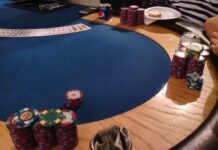The Upswing Poker Lab is a poker training course taught by Doug Polk, Ryan Fee, and other top poker pros. The Lab is updated regularly with in-depth learning modules, theory videos, and a wealth of information to make you a better poker player.
Being short stacked is a situation that happens in all game types. In hyper-turbos and spin-and-go’s, for example, you start with a short stack. And in tournaments, you can expect to be short often.
Here are seven tips that will prepare you for short-stacked situations.
Tip 1: Learn your preflop ranges.
When short stacked preflop, it’s important to use solid opening and three-bet-shoving ranges. You can determine those ranges with trial and error, and by studying good players.
(Better yet, you can borrow world-class pro Nick Petrangelo’s ranges by getting his new Upswing tournament course, Winning Poker Tournaments! Nick’s course comes with 250+ charts for six different stack depths.)
You can also use the SnapShove app, which tells you what hands to open-shove and three-bet shove (it does not provide opening ranges, though).
It’s important to adjust your ranges to how your opponents are playing. You should also stick to your preflop ranges until you have reasons to do otherwise, at which time you can adjust to target the particular mistakes your opponents are making.
Tip 2: Pay close attention to effective stack size.
‘Effective stack size’ is the least amount of chips in front of any player involved in a hand. It’s important to pay attention to effective stack size so that you can adjust your strategy accordingly.
Take a look at this example:
Player A stack size: $50
Player B stack size: $20
Player C stack size: $50
Player A Posts Small Blind of $1
Player B Posts Big Blind of $2
Player C Raises on the Button to $4
Here, the effective stack is determined by player B’s stack, which is $20.
Now suppose that player A is holding ADiamond Suit AHeart Suit. What should he three-bet to? Obviously, he can three-bet anywhere from $6 to $50. But to determine the correct size, Player B’s stack size of $20 needs to be taken into consideration.
A standard three-bet size as the small blind would be $12. This achieves something: if Player B goes all-in for $20 and Player C calls, Player A can reopen the round of betting because the all-in is $8 more than his raise (also $8 more than Player C’s raise), thus allowing for more value preflop.
Tip 3: Consider post-flop playability.
‘Post-flop playability’ is how well your hand hits various flops, and how it plays after the flop.
This is important in short stack formats because after a preflop raise the stack depths are often too short to maneuver post-flop. This means you’ll usually be all-in either on the flop or the turn.
When short stacked with a hand that plays poorly post-flop, but is likely to the best hand preflop, jamming all-in is often the best play. It allows you realize all of your hand’s equity and avoid tough post-flop decisions. Examples of hands to jam with include small offsuit A-x hands and low pocket pairs (22–55).
Just make sure to make this play only when under 20 big blinds deep.
Tip 4: Don’t shove all-in for too many big blinds.
It may seem like a good option to jam all-in for 25 big blinds from middle position with a hand like ASpade Suit 5Diamond Suit. However, the risk-to-reward of such a play is poor. You’ll usually either win a small pot or lose a big one.
Instead, the optimal play is to use more standard sized raises, or fold when holding a weaker hand and/or expecting other players to three-bet. Save your stack for better spots and stronger hands.
Tip 5: Don’t be timid.
Inexperienced players are often too passive at shorter stack depths. They fold almost everything, waiting for a premium hand to double their stack.
Playing tight can be the correct strategy in some cases — most notably on money bubbles of tournaments. But playing tight too often will lose you more chips in the long run.
The same applies to limping on the button. As a general rule, don’t limp the button. Your opponents will notice, can assume you are doing it with weak hands, and can easily steal your limps by isolating.
Instead, raise either with the intention to win the blinds or to gain value from calls.
One final way of playing too tight while short stacked is to under-defend from the big blind.
Your opponents can profitably raise smaller with a wide range of hands if you fold too often from the big blind. Allowing them to pick up a free blind every orbit amounts to gifting them a 5 percent (or more) increase to their stack.
To stop opponents from abusing your blinds, defend by calling or raising a decent range of hands.
Tip 6: Never choose to be short stacked.
This applies to cash games and tournaments with add-ons, where you have the option to buy in for less than the maximum.
Choosing to sit with less than the maximum hurts your chances of beating every opponent in your game. It can prevent you from making the correct play, or from putting pressure on those opponents with equal or larger stack sizes. In short, it means you’re leaving money on the table.
Sometimes, however, sitting short is a good idea. Namely:
- To lower your variance when taking a shot at a higher stakes game.
- When the strongest players in the game are deep and the weakest players are short.
Tip 7: Expect variance, and prepare for it.
Short-stacked poker can leave you with a lesser edge than you might have in deep stacked formats. This is usually offset by the fact you can play many more hands in the same amount of time.
But with a lesser edge comes heightened bankroll requirements. Hyper-turbos, for example, require more buy-ins than other formats. Failing to account for this can be your demise of even very competent players. So, it’s important to find out how many buy-ins you’ll need for your chosen short stack format.
Learn the basics of bankroll management here.
Conclusion
Time spent studying effective short-stack play will lead to gains of knowledge and an increase in your win rate. Though, as always, studying is no substitute for playing. So get out there and try some short-stacked formats for yourself. And good luck!












